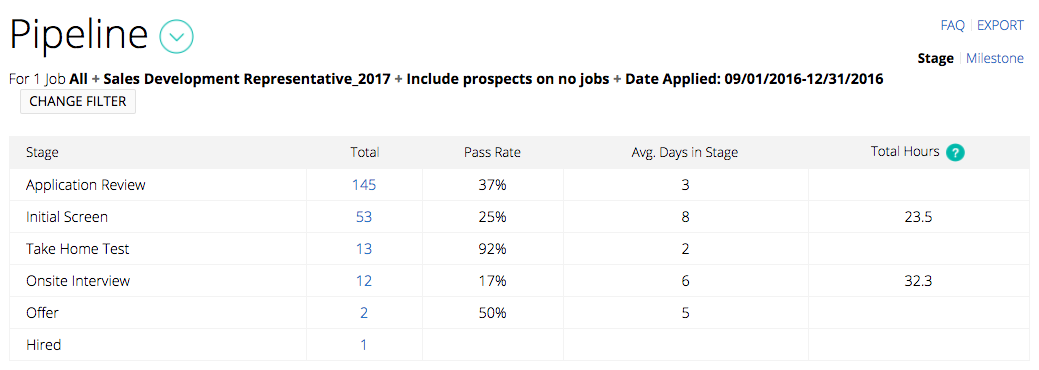The importance of recruitment data

7 mins, 49 secs read time
There’s a lot of talk about the importance of data in recruiting these days, and for good reason, too! As recruiting teams evolve their understanding of the recruiting funnel and implement metrics-driven approaches similar to that of sales and marketing teams, taking a closer look at how we use and report on data is a natural and necessary outcome.
Our Recruiting team at Greenhouse is no stranger to this movement. We use five KPIs, or Key Performance Indicators, to measure our team’s progress and performance quarter by quarter (you can read about our KPIs here). That said, KPIs are a high-level metric, and in this post I’d like to show you a more granular, day-to-day use of data.
So, why is data in recruiting important?
Ultimately, your hiring managers are leaders with a lot on their plates, and the hard truth is that they have to prioritize a lot of other daily responsibilities over recruiting. But that’s okay, because that’s where you can shine. Our job as recruiters is to be proactive partners and to keep our hiring managers up-to-date by providing data on their job search that’s synthesized and helpful. And one of the main ways we can do that is through reports. I outline a few essential types of reports below.
#1: The Pipeline Report
The Pipeline report is one of the simplest, yet most telling reports. It's a snapshot of the recruiting funnel for a given job (or jobs) in a selected timeframe. This report lists every stage of an interview process for that job and offers high-level data about the candidate activity in each stage. Making sure you have an ATS that gives you this level of insight will allow you to assess the health of your recruiting pipeline at any given moment.
As you can see in the image below, the way we organize this information in Greenhouse is through a few categories:

Total: The total number of candidates who have entered this stage.
In the numbers above, I see that I had to complete 53 initial screens to result in 1 hire for this role. This is really good information to use as a benchmark, especially if my hiring manager is expecting to hire more than one person for their role.
Pass Rate: The percentage of candidates that move out of or “pass” a stage into the subsequent one.
In the Pipeline Report above, the Pass Rate for the Take Home Test (THT) stage is a red flag to me. 92% is a very high conversion, meaning this stage is not a strong filter, especially when the next stage is the Onsite Interview, the most time-consuming stage in my process. Immediately I’m asking myself, is the THT stage filtering out enough unqualified candidates? If not, how can we better vet candidates before we bring them onsite?
At Greenhouse, I once experienced the opposite problem. The THT stage had a pass rate of only 10%, which was resulting in very few onsite interviews and a very anxious hiring manager. So after digging deeper, the hiring manager and I concluded that certain aspects of the test were filtering out candidates too aggressively. Ultimately, by reworking our THT, we increased the average conversion rate to 50%, which exposed us to meeting more candidates face-to-face and allowed us to get a better sense of the talent on the market.
Average Days in Stage:The average number of days a candidate spends in one stage.
This metric offers insight on where in the process you’re efficient and where you might need to speed things up. Especially in a competitive market, the speed of your recruiting process is a huge differentiator. If you want to hire the best people for your team, you have to remember that the best candidates are heavily pursued by other recruiters and employers. So making your candidates feel like a priority by being quick to respond and taking action in an interview process goes a long way.
In the Pipeline Report above, the fact that candidates spend an average of 11 days in the Initial Screen stage is a red flag. I’ll ask myself: Is this a coordination issue on our end, or are candidates themselves taking a while to respond? In either case, what can we do to fix this problem?
Total Hours: How much time you and your team are investing in interviewing.
The Pipeline Report above shows that I’ve spent 23.5 hours total conducting initial screens for that role. (The way Greenhouse calculates this number is by taking the time you’ve outlined your Initial Screen interview should take and multiplying that number by how many Initial Screens you’ve scheduled.) This kind of data is particularly useful in setting expectations for your hiring manager when you begin a job search. At Greenhouse, we pull historical pipeline data to show our hiring managers not only the number of interviews they should expect to do for their role, but also the number of hours they and their teams can expect to spend interviewing. That way, we can use this information as a benchmark for our process moving forward. So let’s say I’m working on a role where I expect 7 onsites to result in a hire but I see that our team has conducted 12 onsites so far, as pictured above. Communicating how many additional hours the team’s spent interviewing so far may help you and your hiring manager discuss 1) whether we trust the hiring process to inform us when we have someone worth hiring and 2) whether our process is working as well as it should.
#2: Weekly recruiting update
The Weekly recruiting update refers to another feature in Greenhouse that provides a list of active candidates in selected interview stages in your process. If you don’t have such a feature handy, I’d still recommend compiling the data manually for your hiring managers, as I used to do in my pre-Greenhouse days. I promise your hiring managers will appreciate it (whether they tell you or not)!

In this report, I can customize the stages featured. In the image above, I’ve chosen to generate a report of the candidates in the THT and Onsite Interview stages. This is more meaningful data for my hiring manager than a list of everyone in the Initial Screen stage because 1) these candidates will involve time from the entire interview team and 2) they’ve already been vetted by the Application Review and Initial Screen stages and are therefore considered more qualified than the average applicant.
Another aspect of this report is that candidate names are hyperlinked to their profiles in Greenhouse. That way, if your hiring manager wants more details on a particular candidate, they can easily click into Greenhouse. The information on our candidates is so accessible that it’s hard for your hiring manager not to get involved!
On a personal note, I send this Weekly Recruiting Update to each of my hiring managers every Friday, adding quick, one-line summaries of each candidate listed. Providing a consistent, weekly update is a great practice for keeping your hiring managers engaged and aware of the work going into their search.
#3: Quality of candidate source
Quality of candidate by source is another nifty reporting feature in Greenhouse. Essentially, it measures the effectiveness of the sources you’re utilizing to generate candidates. In Greenhouse, this report tells you not only the quantity of candidates each source generates (sources being company marketing, prospecting, referrals, third-party job boards, etc.), but also the quality of the candidates generated measured by how far they make it through your interview process. The importance of data in recruiting when it comes to candidate quality can’t be overstated—you have the ability to make a tremendous financial impact on your team by making sure you invest your dollars in the sources where you see the greatest return.
Speaking of quality, it’s well accepted in the recruiting world that referrals are a great source for qualified candidates. Using the Candidate Quality by Source report, you can prove this to your hiring manager and incentivize them and their team to make more referrals (as well as post the job description to their social networks – another feature in Greenhouse). For example, in Q3 of 2016, 5% of our referrals were hired, which is an immensely higher percentage than the .03% of non-referred applicants hired during that quarter. Communicating these data points to your entire company can help result in more referral activity.
Conclusion
Again, there’s no denying the importance of data in recruiting! There’s immense value to tracking KPIs to measure the effectiveness of your recruiting process, but I hope that through reading about these quick and easy-to-pull reports, you’ve been able to get a better sense of how to use data on a day-to-day basis to keep your hiring manager informed and involved.
Whether you have Greenhouse, a different ATS, or none at all, these are metrics you can leverage to offer valuable insight into your recruiting workflow. The main takeaway here is that providing increased visibility into your efforts as a recruiter leads to more buy-in and trust from your hiring managers, which allows you to be a more successful strategic partner in the long run.